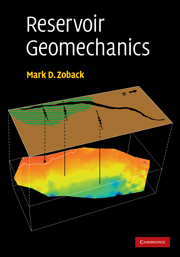Book contents
- Frontmatter
- Contents
- Preface
- PART I BASIC PRINCIPLES
- 1 The tectonic stress field
- 2 Pore pressure at depth in sedimentary basins
- 3 Basic constitutive laws
- 4 Rock failure in compression, tension and shear
- 5 Faults and fractures at depth
- PART II MEASURING STRESS ORIENTATION AND MAGNITUDE
- PART III APPLICATIONS
- References
- Index
- Plate section
2 - Pore pressure at depth in sedimentary basins
Published online by Cambridge University Press: 10 December 2009
- Frontmatter
- Contents
- Preface
- PART I BASIC PRINCIPLES
- 1 The tectonic stress field
- 2 Pore pressure at depth in sedimentary basins
- 3 Basic constitutive laws
- 4 Rock failure in compression, tension and shear
- 5 Faults and fractures at depth
- PART II MEASURING STRESS ORIENTATION AND MAGNITUDE
- PART III APPLICATIONS
- References
- Index
- Plate section
Summary
Pore pressure at depth is of central importance in reservoir geomechanics. In Chapter 1, I referred to the fact that pore pressure and stress magnitudes are closely coupled (Figure 1.4). The importance of pore fluids and pore fluid pressure on the physical properties of reservoirs is discussed in Chapter 3 in the context of effective stress (the difference between external stresses acting on the rock matrix and pore pressure) and poroelasticity. In Chapter 4, pore pressure is shown to have an effect on the strength of both intact and faulted rock. Elevated pore pressures pose a severe risk during drilling when hydrocarbons are present and place important constraints on the density of drilling mud (i.e. mud weights) used during drilling (Chapter 10). Elevated pore pressure also influences maximum hydrocarbon column height in some reservoirs as well as the leakage potential of reservoir-bounding faults (Chapter 11). Reductions in reservoir pore pressure with production (depletion) can cause significant deformation in a reservoir including compaction and permeability loss (especially in poorly consolidated and weak formations) and, perhaps counter-intuitively, induce faulting in some reservoirs in normal faulting regimes or the surrounding region (Chapter 12).
I review several fundamental principles about pore pressure in this chapter. First, I define pore pressure and discuss variations of pore pressure with depth. Second, I discuss the way in which a reservoir can be hydrologically subdivided (compartmentalized) into distinct pressure and flow units. Third, I briefly discuss some of the mechanisms of overpressure generation that have been proposed.
- Type
- Chapter
- Information
- Reservoir Geomechanics , pp. 27 - 55Publisher: Cambridge University PressPrint publication year: 2007



